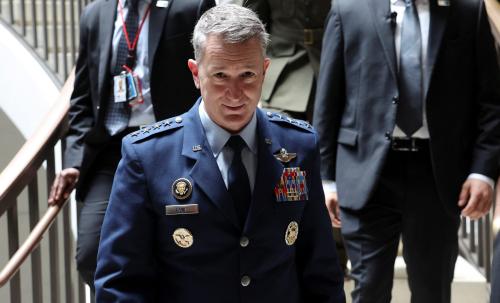“There is widespread agreement, I believe in both parties, that we have cut defense too much,” Rep. Mac Thornberry said at a Brookings event this week. “We are roughly 20 percent below what it was in 2010.” Rep. Thornberry (R-Tex.), chairman of the House Armed Services Committee, discussed military readiness, innovation, the defense budget, and related issues with Senior Fellow Michael O’Hanlon, co-director of the Center for 21st Century Security and Intelligence.
To start the program, O’Hanlon asked the chairman to summarize the Department of Defense (DOD) acquisition reform bill (the Defense Acquisition Streamlining and Transparency Act) that aims, among other goals, to make the department make more use of commercial marketplaces. During the discussion at Brookings, Chairman Thornberry emphasized that the world’s complex defense challenges require agility and innovation, and “getting the best our country can provide into the hands of the war fighter in a timely way.” Watch:
“One of the reforms we propose,” he said, “is to allow DOD to buy things commercially online, like Amazon business-to-business.”
The Trump administration’s latest budget request released this week proposes a $54 billion increase in defense spending for 2018 (this figure is measured against the 2011 sequestration cap; O’Hanlon has explained how the actual increase relative to the recent past is more like $20 billion). Chairman Thornberry and his Senate counterpart John McCain (R-Ariz.) have pressed for $37 billion increase above the president’s proposal. When asked to discuss the increase, the congressman noted that the administration’s proposed budget is 3 percent more than what President Obama had suggested for this year, and a 5 percent increase over current funding. “I think it’s fair to say basically the Obama approach with a little bit more, but not much,” he said. Watch:
Thornberry added:
I’m afraid when we talk about budgets we get into these numbers games … What we lose sight of is what those numbers mean, and which capabilities are we willing to forgo with a different level of budget. I think we have to be concrete about that. Because the men and women out on the front lines will have their life affected by what we’re not fixing, by the new capability were not getting, or whatever choice were making. We need to make it more concrete.
$640 billion is the base budget for DOD and the Department of Energy (nuclear weapons) and does not include war costs (overseas contingency operations), O’Hanlon pointed out.
The conversation turned to specific issues of force structure and readiness, especially in the Air Force and the Army. Chairman Thornberry emphasized that “you cannot accomplish these goals in a budget or two. It takes time … it takes 10 years and $10 million to grow a fighter pilot,” for example. Watch:
In February 2017, General David Allyn, the Army vice chief of staff, testified to Congress that about a third of the Army’s 58 brigade combat teams (BCT) would be ready to fight in 30 days, and only three “could be called upon to fight tonight in the event of a crisis.” O’Hanlon observed to Chairman Thornberry that “the Army is still talking today in the same kind of dire tones that it was two or three years ago … about the state of readiness, the lack of proper full unit training and exercising. So, what is going on?”
“We have not been spending money efficiently,” the chairman began, and “we are cannibalizing army units in order to make those that we are sending on deployments full.” Watch:
O’Hanlon followed up with the question of whether units that are forward deployed and rotated (such as units now in Poland and the brigade in South Korea), which is a strain on the Army, should be considered “permanent presence,” and deployed with families. “Yes, I think so,” Thornberry replied.
We have asked for a study just on cost at least of permanent presence in Eastern Europe versus the rotation. And that’s just dollars. What we’re talking about is the human toll on families and elsewhere. And I do think we ought to look at those options. Part of the reason we ought to look at them is to show our commitment to allies in various parts of the world, but part of it is strain on the force. And then we need to evaluate. I don’t know what the cost data will show. I’m not convinced that it is tremendously cheaper to rotate a bunch of units through rather than have that permanent presence.
While the president’s budget calls for spending increases in defense, homeland security, and veterans’ affairs, it contains steep cuts to many other discretionary categories, including foreign affairs. “How do we pay for it?” O’Hanlon asked. “Are there certain principles you would at least counsel us to bear in mind as we think about how to pay for these needed increases?
“Principle number one,” Thornberry replied, “is the first job of the government is to defend the country, and so the first dollar we receive from taxpayers ought to go to that purpose, and everything else is secondary.” Watch:
Chairman Thornberry said there is an opportunity “if we can get people of good will on both sides to sit down and look at these big moving pieces, we can put defense and everything else on a better track.”
“There is widespread agreement I believe in both parties,” he added, “that we have cut defense too much.” Continuing, he said:
If you look back at what we’re spending now versus 2000, before 9/11, our defense budget has gone up about 40 percent. Over that same period the Chinese defense budget has increased four times. The Russians about three times. And just in a bit of context, we spend three times as much on Medicaid today as we did during Bill Clinton’s time.
So, that is where the growth has been. It’s been in mandatory spending and it’s been with our adversaries. It has not been with our defense budget. And we are paying the price for it.
My job is to describe what I think is necessary to fix the problems, and to try to be as effective an advocate as I can be for the men and women who risk their lives on the front lines to keep us safe. And so that’s what I’m going to do. I cannot tell you how all the Washington games will play out. But I can tell you is that we have … not just needs, but real damage that needs to be repaired, and our adversaries are not sitting still.
Get a full transcript and full event audio on the event’s page.
The Brookings Institution is committed to quality, independence, and impact.
We are supported by a diverse array of funders. In line with our values and policies, each Brookings publication represents the sole views of its author(s).








Commentary
Rep. Mac Thornberry: We have cut defense too much
May 24, 2017